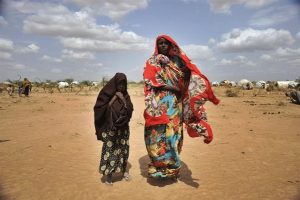“The worst drought in 60 years”
Thousands of people across the Horn of Africa are facing severe food and water shortages in what is being called “the worst drought in 60 years”. At the same time, high food prices are amplifying the drought’s impact.

Hawa Issak lives with her son in the Ifo refugee camp, in North Eastern Province, near the Kenya-Somalia border.
UNICEF/NYHQ2011
The Global Polio Eradication Initiative (GPEI) and its lead technical agency the World Health Organization (WHO) are working with several aid and humanitarian agencies, along with the governments of the affected countries, in a coordinated response to the escalating crisis.
With little access to food and water, and with ongoing conflict in some areas, many people are faced with little choice but to pack up and leave their homes and livelihoods. Refugee camps are facing an influx of thousands, and are subsequently having to look after many more than they were initially designed to care for. In June alone, over 30,000 Somali refugees were registered at the Dadaab Refugee Camp in northern Kenya, bringing the population of the camp up to more than 370,000.
The WHO in Kenya estimates that 20 to 34% of women and children in Kenya are suffering from global acute malnutrition. But beyond the clear dangers of malnutrition and dehydration, outbreaks of diseases are a constant threat. Reaching people with vaccines is complicated by the high levels of population movement, while the movement itself enables diseases to spread more quickly over a wider geographic area. People weakened by inadequate nutrition are also more vulnerable to infection. The lack of adequate sanitation has already led to deadly outbreaks of diarrhoea in Djibouti and Ethiopia. In the Dadaab camp, there have been 462 laboratory-confirmed measles cases, including 11 deaths. The threat of cholera and visceral leishmaniasis are spectres looming over the region.
The WHO is coordinating with many of the key players in international aid and working alongside the governments of the affected countries to help ensure their health, water, food and sanitation needs are met.
One example of multi-agency cooperation is the mass measles immunization campaign, launched under the leadership of WHO, taking place from 25-29 July. The campaign will target 215,000 children under five years of age in the Dadaab refugee camp, as well as the host districts of Fafi, Lagdera and Garissa in Kenya. Oral polio vaccine (OPV) will also be administered during the campaign. WHO will provide technical capability, funding and OPV, while UNICEF will provide measles vaccine and social mobilization expertise.
The hundreds of skilled polio personnel in the Horn of Africa have been involved since the crisis began. Polio resources such as communications and transportation capability have also been made available. An existing Horn of Africa-wide body for collaboration on polio eradication has now expanded its mandate to deal with the drought. And while insecurity is an increasing problem, the polio network has been involved in initiating dialogue and developing plans to reach vulnerable populations in the coming weeks.
Child Health Days (CHDs), largely run by polio-funded staff, have already begun in Somaliland, Somalia, providing mothers and children with a package of health interventions including OPV, tetanus toxoid (for mothers), and measles vaccines, deworming treatment, nutritional screening and referral. Similar CHDs will take place in Puntland, Somalia from 17-21 July.
Polio staff are on guard for any new polio cases. They are also being used to ensure the overall health and wellbeing of those impacted by the drought. The existing polio surveillance network has been put on a heightened state of alert to monitor for any outbreaks in the Horn of Africa and its neighbours; and polio vaccines are being delivered as an additional health measure whenever possible. An important priority of the crisis response is to protect children in the region from polio and to prevent an outbreak. The last large outbreak in the Horn of Africa – originating in Nigeria – eventually spread all the way to Indonesia and was part of an outbreak which, throughout 2004 and 2005, paralysed 1400 children for life.
The polio funding requirements for all Horn of Africa countries are US$122 million for the next 18 months, with Sudan, South Sudan and Ethiopia accounting for the bulk of the need. A shortage of funding in the first quarter of 2011 forced the scaling back or delays in implementing supplementary immunization activities in Ethiopia, Djibouti, Uganda, Kenya and Eritrea, raising the possibility that large groups of children remain vulnerable to polio, especially as the drought forces more population movement and weakens immunity.
Related documents
Funding requirements for polio eradication in the Horn of Africa
Impact of the drought on health in the Horn of Africa













